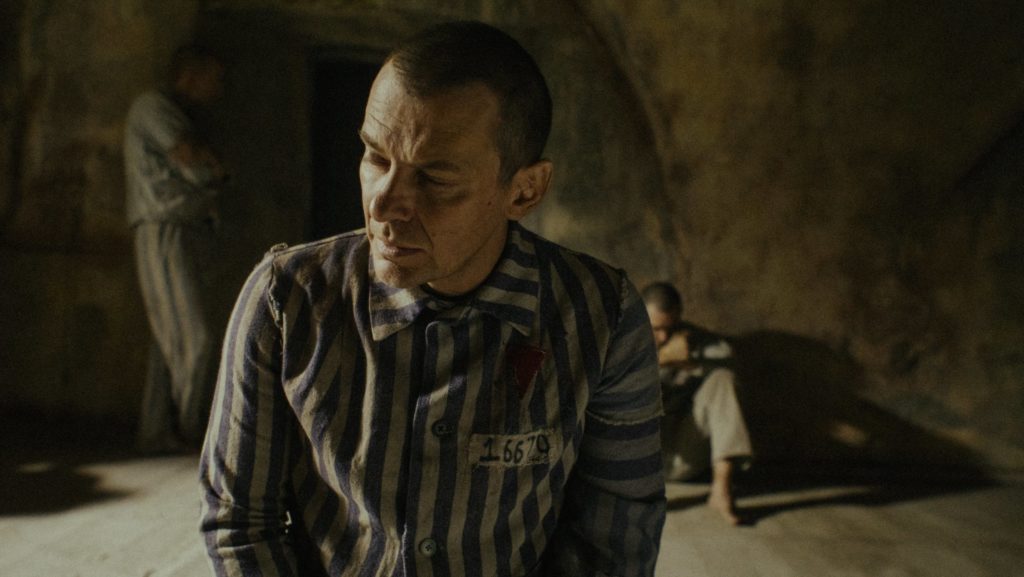Rather than beginning with St. Maximilian Kolbe's early life or missionary work, new film "Triumph of the Heart" opens at the moment many accounts conclude: his entry into the starvation cell.
From there, through flashbacks and intense chamber-drama scenes, the narrative reveals both his extraordinary sacrifice and the humanity that sustained it.
"Triumph of the Heart," premiering Aug. 13 in Poland, is set to arrive in theaters on Sept. 12 in the United States.
It offers a stirring, deeply human portrayal of St. Kolbe -- a Polish Conventual Franciscan friar, missionary, and founder of the Militia Immaculatae movement dedicated to promoting devotion to the Virgin Mary.
In 1941, he was arrested by the German Gestapo police for sheltering refugees, including Jews, in his monastery -- and deported to Auschwitz.
Every time a prisoner escaped, the revenge of the German guards of the camp was cruel. In July 1941, when one of the prisoners disappeared, the Nazis sentenced several people to one of the worst deaths experienced by humans -- starvation.
Franciszek Gajowniczek, a married man and father, was among 10 men condemned to die by starvation. Father Kolbe volunteered to take his place and spent two weeks ministering to the others in the cell. When everyone else was already dead, the Germans had to kill him with a lethal injection on Aug. 14, 1941.
He was canonized by Pope John Paul II in 1982 as a martyr of charity.
"Triumph of the Heart" directed by American filmmaker Anthony D'Ambrosio, was born out of a personal encounter with St. Kolbe's witness, the director said.
"The story of St. Maximilian Kolbe is fundamentally a story about hope," D'Ambrosio told OSV News.
"In my own life, his story provided a way through a personal crisis of hope. I was struggling with severe health issues, including a debilitating infection and insomnia, which led to a profound loss of faith," he said. "During those sleepless nights, I began meditating on Kolbe's story -- not just his sacrifice, but his time in the starvation cell at Auschwitz, where he inspired hope in utter despair. This connection to his suffering helped restore my faith."
This deeply personal starting point shaped the film's unusual structure. Rather than presenting Kolbe as a distant, already-perfect saint, D'Ambrosio wanted to show the journey that formed him.
"I wanted to peel back the layers of sainthood to show Kolbe's journey of becoming a saint -- the process he underwent to overcome everyday struggles as a disciple of Christ, preparing him to give his life," he said.
The film focuses on St. Kolbe's deliberate choice to die in place of another man, his efforts to inspire hope among the nine other men condemned with him, and his appeal to shared humanity that bridged ideological divides within the cell.
For the director, telling this story as an American meant embracing Polish and Catholic roots of the martyr and his companions with respect and authenticity.
"We filmed in Poland, engaging deeply with the local Catholic community, who provided miraculous support -- from funding to logistics -- within days of our arrival," D'Ambrosio explained. "This grassroots involvement ensured authenticity, as the film grew from the heart of the church rather than Hollywood."
Polish actor Marcin Kwasny, who portrays St. Kolbe, described the role as "the greatest acting challenge of my career so far."
Speaking with OSV News, he said that "it wasn't about losing weight or acting in English, but about the weight of portraying his (Kolbe's) dying in the starvation cell with nine companions. Kolbe changed their perspective on dying."
Kwasny emphasized that "they died with song and prayer on their lips. He comforted them to the very end, heard their secrets, absolved them, and gave them hope against hope. This film is my tribute to one of the greatest Polish martyrs and saints of the Catholic Church."
Producer Cecilia Stevenson and the cast faced an intense production schedule -- only three months from fundraising to shooting -- with unforeseen obstacles, including a snowstorm.
Yet, as D'Ambrosio recalled, "miracles" seemed to accompany the process.
"After a snowstorm derailed our schedule, a replacement team devoted to Kolbe appeared, turning obstacles into affirmations of faith," he said. For the cast, the emotional toll was real. Some actors adopted restricted diets to mirror the prisoners' conditions; others kept emotional distance between scenes to sustain the narrative's rawness.
Przemyslaw Wrezlewicz, a Polish film director who heads the film distribution company Rafael, said the Polish-American collaboration began with a meeting of hearts and minds.
"When we saw the first draft of Anthony's script, we were moved by how deeply he understood the spirit of St. Maximilian -- not only as a martyr, but as a man who lived love for the other person," Wrezlewicz told OSV News. "We immediately felt this was a film that needed to be shown in Poland."
Wrezlewicz believes "Triumph of the Heart" distinguishes itself from earlier depictions by exploring St. Kolbe's final days as a fully human confrontation with death.
"Most films about Kolbe focus on his heroic gesture at Auschwitz, but that's not where the story ends," he said. "This film goes further, showing him as a flesh-and-blood man facing earthly death, with faith, hope and love tested in a place designed to destroy all three."
For both filmmakers and distributors, the film's relevance to today's audiences -- in Poland, the United States, and beyond -- is clear.
"We live in a world that fears sacrifice and selflessness more and more," Wrezlewicz said. "St. Maximilian reminds us that a life built on love, even when it requires sacrifice, brings the deepest fulfillment. In a time when relationships are often superficial and values blurred, his story is like a lighthouse."
D'Ambrosio sees St. Kolbe's witness as especially meaningful for young people.
"Kolbe's message offers hope when circumstances seem hopeless, addressing widespread feelings of doubt, loneliness, and isolation in today's world," he said. "It inspires especially younger audiences to recognize their potential for greatness as saints in their own callings."
Wrezlewicz agrees that the film's emotional language will connect across generations.
"Young people are often unfairly judged as indifferent, but they are deeply searching for meaning," he said. "If we present values authentically -- not moralizing, but telling true stories -- they receive them with great enthusiasm."
"It's not a sermon on the screen," Wrezlewicz emphasized. "It's a moving story about love that transcends death. If, after watching, someone asks, ‘What would I have done in Kolbe's place?' the Gospel has already begun to work."
For D'Ambrosio, the role of cinema in evangelization is not theoretical -- it's personal. "Films like this can peel back layers of sainthood, make the journey of faith relatable, and inspire movements by fostering shared purpose," he said. "In a time of despair, films that come from the heart of the church can draw people back to faith through powerful, human-centered storytelling."
Looking ahead, "Triumph of the Heart" is slated for theatrical release in the U.S., with discussions underway for distribution in Latin America. Wrezlewicz noted that St. Kolbe is a "universal saint" known and venerated in countries from Mexico to Japan, making the film's message accessible across cultures. Filmed entirely in English, it is positioned for international reach.
D'Ambrosio summed the film up simply: "Kolbe's act of love in darkness showed me that Christianity is about being present in suffering. That's the heart of this story -- and I believe it's what our world needs most right now."

